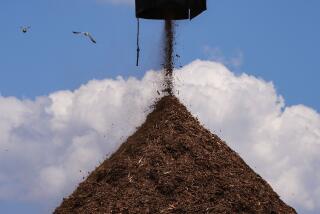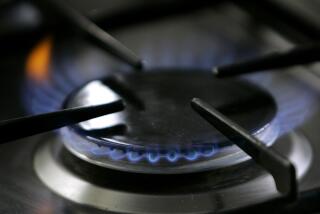When going green warms you inside
- Share via
QUESTION: I’m considering buying a pellet stove and am wondering what your opinion is of its reliability and comfort.
How could I determine the quality of consumer service offered by manufacturers? What is your opinion on buying a pellet stove online?
JULIUS CHAU
San Jose
*
ANSWER: With rising energy costs and growing concern about the environment, many people are searching for alternative heating sources for their homes. One option is the pellet stove, which burns small pellets that look like rabbit feed and offers one of the cleanest -- and greenest -- ways of heating a home. It might be a good idea to start researching now, when you don’t need the heat.
The pellet stove, a free-standing heating device with an intricate interior system, burns pellets made from compacted bark, sawdust, wood chips, agricultural crop waste or waste paper. Some models run on nutshells, dried cherry pits, corn kernels or other waste. Pellets are poured into a hopper and a programmed electrical mechanism dispenses them at a precise rate into a combustion chamber, where they are ignited by a fan. The level of heat is regulated by choosing the desired setting or, in some cases, by being connected to a remote wall thermostat. Because of their high combustion and heating efficiencies, pellet stoves produce little air pollution.
Prices for pellet stoves, which vary in size and power, range from $1,700 to $3,000. The unit needs only a simple venting system instead of a chimney, but installation should be done by a professional. Depending on the size of the room to be heated, the exterior temperature and the desired temperature, a pellet stove will use 35 to 130 pounds of pellets a day and will consume about 100 kilowatt-hours, or about $9 worth of electricity, a month. Pellets from wood byproducts are often sold in 40-pound bags that cost about $5 each.
Although there are websites that sell pellet stoves, it’s best to find a local dealer that offers an in-home service plan for repairs and for highly recommended yearly cleaning and maintenance. The Pellets Fuels Institute (www.pelletheat.org) lists dealers across the country. Make sure the technicians who service your stove are certified by the National Fireplace Institute and ask for -- and follow up with -- references. With the rising popularity of the stoves, new companies are entering the market, but it might be safer to go with an established company. Also ask about local retail sources for purchasing pellets. If a local store isn’t available, you’ll have to order online or by mail and pay for shipping costs, which can get expensive. Before you purchase a pellet stove, check with your local environmental agencies about any wood-burning regulations that may apply.
Although a pellet stove offers “clean” heating, if there’s an electrical outage and your unit doesn’t have a backup source, the system will stop and smoke from burning embers could back up into the house. If you live in an area with frequent air-quality problems that require restrictions on wood burning, pellet burning, though much cleaner, may be prohibited at times. And, lastly, while much attention has been paid to the efficiency of the pellet stove’s interior design, the exterior of many models has been entirely overlooked.
-- Christy Hobart
More to Read
Inside the business of entertainment
The Wide Shot brings you news, analysis and insights on everything from streaming wars to production — and what it all means for the future.
You may occasionally receive promotional content from the Los Angeles Times.









